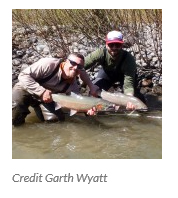Search
Latest Articles
Catching Steelhead on Flies
by Larry Dunbar for AnglersClub.com, October 31, 2015
Over time my success rate swinging vs. nymphing has been about one fish swinging for every five fish caught nymphing. For me, it is a choice between having the most fun or catching the most fish. Most of the time, I choose swinging my flies.
Swinging for Steelhead
I use a two handed Scott L2H with a Skagit head line and a medium speed sinking tip. A good choice for a fall winter fly is something purple in a size-2.
Swinging is a useful technique for bigger freestone rivers. Look for “dancing water”. It doesn’t have to be deep, 3 to 6 feet is good. Speed is important. The water should be traveling at human walking speed, and just dancing over the rocks. No sandy bottoms. A little cover for the fish behind boulders is helpful. Cast the fly across the stream at a 45 degree angle, mend the slack and let the fly “swing down and across” the river. Keep the rod level and pointed at the fly. Stay with it throughout the entire arc until the fly is directly downstream from you. Retrieve the fly, take one step downstream, and repeat the process. If you get a bump from a not too aggressive fish, go immediately back and give him another chance. Otherwise, keep swinging and stepping downstream until the area is covered.
The challenge is to get the steelhead to come up from the lower part of the water column and attack the fly. The closer you get the fly to the fish, the more likely you are to get an attack.
Nymphing for Steelhead
Every technique in nymphing is different from swinging. It works well in a smaller river. Look for classic fishing holes, deeper water, with some structure and a tail out. I use a single handed Sage One, 8-weight with a floating line and sinking tip. This setup is rigged with a nymph and an emerger dropped below it.
Cast above the hole and float the fly through it. The bite is typically light, and often it’s just the line stopping or moving sideways. Lift the rod. Set the hook.
Choosing Steelhead Flies
Steelhead are sea run rainbow trout, but unlike trout, when they are in the rivers they are not eating. No reason to match the hatch. Some say presenting the fly to steelhead is like presenting dessert after a big meal – they’ll probably pass, but presented often they may change their mind.
Bigger flies work better in colder water. This time of year and on into the winter, size-1 or size-2 work well. You can go down to size-6 in summer. Sunny skies make muted colors show up better in clear water, and oranges and reds in dirty or colored water. For dark skies use blue, black, purple.
Finally, rain and rising water makes the fish move upstream and become more aggressive. The best fishing is when the water level is falling after the rain.

Reprinted with permission of Anglers Club Magazine.
